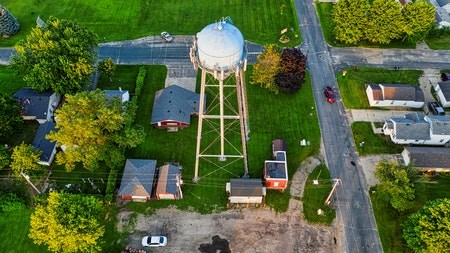Rainwater on the roof usually flows into gutters and downpipes and into stormwater drains to become part of the wastewater system. But rainwater is ideal for watering gardens, flushing toilets and even washing clothes, so it makes sense to find ways of harvesting this valuable water source.
The answer is to install one or more water tanks to collect the rainwater and put it to good use. Apart from being a boon for the ecology, you can use water in more flexible ways with tank water on-tap.
You can't use water from your rainwater tank for drinking water unless it has been treated with an approved water sanitation process. Raw water can harbour some nasty organisms and substances that present health hazards, so it’s not worth taking that risk.
DIY
Some companies specialise in installing water tanks for home use. However, with basic DIY skills, you should manage it yourself.
Check with your local municipality and water authority before buying and installing a rainwater tank. Some local authorities may require building approval for domestic water tanks.
You should hire a licensed and registered plumber to make connections for items connected to your main water supply, such as washing machines and toilets.
Materials needed will include:
- Tank
- Prefiltration equipment. Options include a tank filter screen fitted beneath the tank lid to filter out smaller debris and insects; a rain-head to remove larger debris; a first flush rainwater diverter to take off all initial dirty water.
- Pump, pump cover and pump to tank connector kit
- Pipes – standard PVC in 110, 80 or 75 mm
- Elbows to match pipe sizes
- Ball valves to isolate components and manage the system
- Non-return valves
- Float valve kit
Tank size
With water, storage size counts. According to the JoJo water storage installation guide, the most common mistake in unsuccessful rainwater harvesting systems is a lack of storage capacity.
When the downpours arrive, a large tank will store more before the excess runs off to drains, streams and the sea. That means you will have more water to last you until the next rain.
To find the right tank for your needs, consider the rainfall in your area, the size of your roof and what the water will be used for.
For example, a roof area of 100 m2 will deliver 2 500 litres in a 25 mm rainfall event.
These size guidelines will help you select the right tank for your needs:

Tank site
Carefully choose the place for your tank. It should be accessible, close to a downpipe, not blocking access, and discreet. If the ideal position isn't readily available, you can reposition the tank using proper piping and guttering.
Tanks must be installed on a level, sound and smooth surface free of protrusions. Level paving will suffice, or a properly designed tank stand. Alternatively, it would be best to build a concrete slab with a concrete surface bed at least 85 mm thick and at least 100 mm wider than the tank's base.
Ensure the concrete is cured before installing the tank and that overflow water won't undermine the base.
Installation
Each tank has slightly different installation requirements, so you should carefully read the instructions to install it correctly and not void the warranty.
These steps apply to most tanks:
- Select and fit the desired pre-filtration options best suited to your needs.
- Remove the existing downpipe from the elbow and redirect it to the inlet screen of your tank. Achieve this by making new pipework with a combination of pipe and elbows of 45º and 90º.
- Cut a hole of 110.5 mm in the middle of the lid and fit the pipe through the hole, stopping before the mesh/tank screen. A hole slightly larger than the pipe will make it easier to lift the lid over the pipe if you need to clean the tank.
- First, install all of the parts without glue to make sure they fit correctly and that the pipe can be secured to a wall or the tank with brackets. Remember that water weighs 1kg/litre, so they are heavy when the pipes are full. Before taking them apart for the final installation, mark them to ensure they’ll fit together exactly as before.
- After installing the outlet connections - in case you have to move the tank - disassemble the inlet pipe connections and reassemble using PVC pipe primer and adhesive.
- Connect your pump to the tank.
Professionals
If you prefer a professional instal your tank, JoJo has a list of recommended installers here.
These installers have been carefully screened to ensure they have the right equipment and experience to do a good job. They are also required to complete a range of courses to meet JoJo's criteria.
Installing water tanks is cost-effective and will allow you to have an uninterrupted water supply. Doing it right, however, is of utmost importance.



